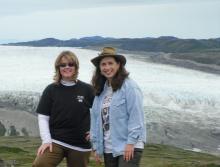
Snow Drifts on the West Antarctica Ice Sheet (WAIS), Antarctica
The research team studied the microstructure of ice crystals on the West Antarctic Ice Sheet (WAIS). As the research title of their project implies, "VeLveT Ice", the team is researching what happens at the small scale of individual ice crystals that ultimately affect the large flow patterns in an ice sheet. The group is therefore studying the link between crystal properties, ice flow, and climate history because the crystal structure retains a memory of past climate which is recorded differently than "normal" ice core analyses. Ice crystals grow, rotate, and recrystallize with time and flow in an ice sheet. The rate at which each of these processes occurs depends on the temperature, state of stress, and impurity (e.g. dust, ash or salt) content of the ice. The orientation, texture, size and shape of the crystals in a given block of ice evolves through time, but also "remembers" past temperature and flow. Many scientists have observed that these microstructural properties vary with depth in an ice sheet and climate history. For example, ice from glacial time periods typically has smaller crystals, higher impurity content, and stronger fabric than ice from interglacial time periods. These microstructural properties also affect how the ice flows—ice in an ice sheet is far from a homogeneous substance and variations in properties on the small scale can affect large-scale flow patterns.
This project specifically investigated the ice microstructure, impurity content, and ice-flow patterns in relation to climate history for the ice near the West Antarctic Ice Sheet (WAIS) ice core site, using a combination of borehole logging, modeling, and thin section analyses. This work was the first to combine two novel advanced techniques for studying the relationship between ice microstructure, deformation, and climate history. More information about the project can be found here.


 Snow Drifts on the West Antarctica Ice Sheet (WAIS), Antarctica
Snow Drifts on the West Antarctica Ice Sheet (WAIS), Antarctica
